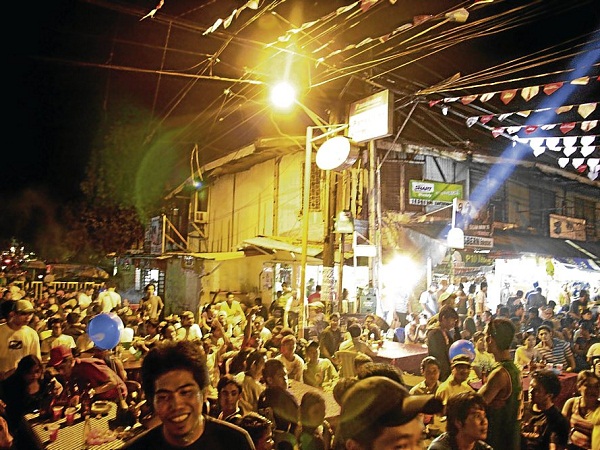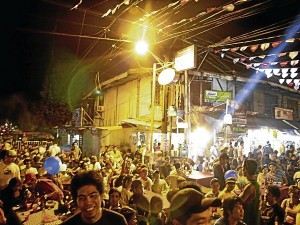 As early as during check-in, B and I were already listing down the places we would go to feed, and what shall comprise our feeding: lunch at fake Bob’s. Pa-a at Manukan. Dinner at Aida’s. Pecan Pie at Calea’s. Taste Station.
As early as during check-in, B and I were already listing down the places we would go to feed, and what shall comprise our feeding: lunch at fake Bob’s. Pa-a at Manukan. Dinner at Aida’s. Pecan Pie at Calea’s. Taste Station.
We were both bleary from respective bouts of insomnia, but Bacolod City is so small you can easily enumerate the places you want to go to. In our case, these are places that mostly involve copious amounts of food.
If you are there for slightly more cultural reasons than chicken breasts, you can go to the Ruins: a grand, photogenic skeleton of a burned down mansion. Exploring the place used to be free, and the younger version of B and his friends reportedly used to bike down its overgrown path after school and play amongst the rubble.
Now there’s a minimal charge of P60, but it’s well worth it. It’s inclusive of a tour, and the tour guide is a part-time comic. Or you can drive to nearby beaches and mountains, and stumble upon places by accident.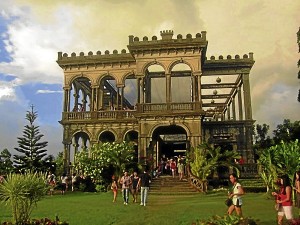
We arrived at Bacolod hungry, gathered our baggage and bearings, and took a 45-minute cab ride from the Silay airport to the Torre household. It’s a big, breezy home perpetually filled with delicious smells, the cutest kids, and the coolest family: Tito Spanky, Tita Maida, Katha and Lui.
For lunch we feasted on shrimp, blue marlin, liempo, crabs, and chicken soup in ubad (banana stalk): all home-cooked, all fresh, all insanely good. This comprises the one and only downside to staying with this troop: Tita Maida and Lui cook so well you end up not wanting to move. In fact, after meals, no one leaves the table, unless it’s to buy something for dessert.
Pre-Masskara
When we finally manage to, we headed to the Art District, or more precisely, the place with the huge billiard balls and cool robots made of recycled parts. The place is packed, as only a pre-Masskara Thursday could pack them. Everybody knew each other; even the tourists knew each other, too.
The amplified mash-up of English, Ilonggo, and Tagalog soon compelled me to get started on rum cokes. The primary essence of the Masskara festival is to drink one’s self to oblivion, so I’ve been told. But I’m sure the Mayor may have something to say about that.
I have only fuzzy recollections of last year’s Masskara, not because I had successfully achieved this goal, but because of an awful eye infection that turned everything around me fuzzy. I was under strict medical warning not to consider anything remotely fun, so we had to avoid the entire stretch of Lacson Street altogether.
Masskara turns the city’s entire main avenue into an outdoor bar, by the way, and everyone, and I mean everyone, is either a) trying to dance; b) guzzling down some alcoholic fluid; or c) puking. But I exaggerate. Slightly. In any case, none of these were particularly good for my eye.
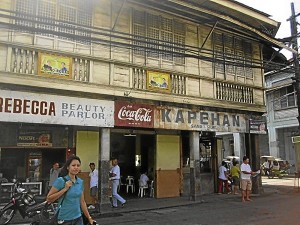 So instead we took Borgy’s reliable old van and drove to Silay, a town 15 kilometers northeast of Bacolod, where the people are happy not to have to deal with all the excitement of Masskara. We had P14 cups of coffee at the New Silay Coffee House, where cock derby announcements fill the walls, and men in faded jackets are immersed in what seemed to be profound thoughts.
So instead we took Borgy’s reliable old van and drove to Silay, a town 15 kilometers northeast of Bacolod, where the people are happy not to have to deal with all the excitement of Masskara. We had P14 cups of coffee at the New Silay Coffee House, where cock derby announcements fill the walls, and men in faded jackets are immersed in what seemed to be profound thoughts.
We went to watch locals contort their bodies at sepak takraw, then cruised down roads that had sugar cane fields on either side of them, stretching on to forever. We took photos of children walking home from school, and silhouettes of farmers at work with their weapons.
In Sagay we went to an enchanted house on stilts: a place of bamboo, colors and texture, mostly built by artist Nunelucio Alvarado and his family. It is a cultural hub by the sea, an art hut that drew artists and travelers from all over to create and congregate. It is a place of stillness and spirit, of quiet and creative chaos. We had fish on the balcony, flanked by carvings and wooden sculptures. I did not want to leave.
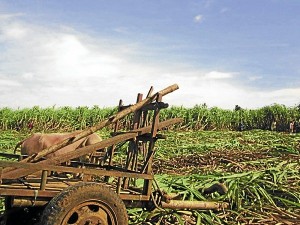 We went to Murcia, to see the house the protagonist in Erik Matti’s “The Arrival” kept seeing in his dreams. “The Arrival” is a personal film of the director, which I love primarily because of how it rendered the fantastic beauty of a small, simple town. It is exactly what Silay, Sagay and Murcia have: all the sweetness of Bacolod, but without the big malls, branded restaurants, and packs of tourists.
We went to Murcia, to see the house the protagonist in Erik Matti’s “The Arrival” kept seeing in his dreams. “The Arrival” is a personal film of the director, which I love primarily because of how it rendered the fantastic beauty of a small, simple town. It is exactly what Silay, Sagay and Murcia have: all the sweetness of Bacolod, but without the big malls, branded restaurants, and packs of tourists.
Cooked on the street
In such towns you automatically gravitate toward food cooked on the street. In Murcia they have this grilled, sweet bread, poked into a stick and sold on the streets along with innards. It is eaten whilst taking bites of isaw, so positively sumptuous that I have been tempted ever since to attempt a living out of this in Manila.
We passed by the mysterious Kilometer 25 (or was it 24?), where inside the car it feels as if you are going downhill, hood first, when in reality your vehicle is moving backwards. Then the fields of sugar cane turned a dusty gold and the sky transmorphed into a brilliant pink, and we’d become characters in a movie. The working plot: Protagonists had to miss the tourist-y Masskara, but…. got to frolic in real Negrense magic in return.
We drove back to the city as it began to get dark, one glorious vision shining in our heads: a huge, hot bowl of kansi. Small towns may have the recipe for a good indie romance, but only Sharyn’s in the city has cow knees boiled to our notion of perfection. We made it to the Spartan eatery in time; a slight drizzle had just begun to fall. Exhausted, hungry, high, it would make for a lifetime of happy memories.
This year we went back to Sharyn’s, still located at the Shopping Commercial Center. As usual, the family who owns it refused to divulge their recipe. They have absolutely no plans of branching out in some air-conditioned mall either, making them the equivalent of a cool, underground band who actually want to stay underground.
This year, too, I missed out on Masskara again. My eyes were fine, but I passed out before anything properly festive could begin. You try staying awake with a stomach full of cake and rum coke. It simply doesn’t happen.
And so, I can’t wait for next year.

